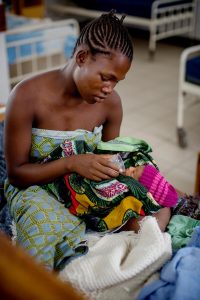
Fra artikkel i Redd Barna-magasinet 3/2016: Judith Gwilizah (baby Jenny) Premature babyer reddes ved hjelp av kengutu-metoden og amming. Vi er på nyfødtavdelingen ved Queen Elizabeth Central Hospital i Blantyre, landets nest største by. Her er det opprettet en egen Kenguru-avdeling, der mødre til premature barn får hjelp til å håndtere de bittesmå babyene. Hudkontakten og varmen fra morens kropp gjør at for tidlig fødte babyer kan overleve uten tilgang på kuvøser, maskiner som overvåker pusting eller annet avansert utstyr. Slikt er det altfor lite av på sykehusene i Malawi. De få kuvøsene vi ser på nyfødtavdelingen er gamle og utdaterte, og det ligger gjerne 3-4 babyer i hver. Men det disse barna trenger er ikke først og fremst kuvøser; det er tettere kontakt med mor som redder livene deres. «Hvert eneste barn er en gave» - Enkelt, billig og effektivt. Fint for både mor og barn. Prosjektleder Lydia Chimtembo i Redd Barna kan ikke få rost kenguru-metoden nok. Ideen er at sårbare premature babyer har det best hud mot hud, og at barna skal svøpes på mammas bryst slik at det etterligner kenguru-lommen. Når babyen ligger inn til mamma døgnet rundt, er den sikret både varme og brystmelk. Kenguru-metoden ble første gang prøvd ut ved et av Malawis sykehus i 1999. I dag har alle sykehus i landet tatt i bruk metoden, men i begrenset grad. - Noen praktiserer den mer enn andre, forteller Chimtembo. – Dessverre synes ikke enkelte at det er bryet verd å prøve å redde de minste barna. Men hvert eneste barn er en gave, og vi skylder å gi det en sjanse til å overleve og vokse opp, sier hun.
Background
In high syphilis prevalence settings, the syphilis testing and treatment strategy for mothers and newborns must be tailored to balance the risk of over treatment against the risk of missing infants at high-risk for congenital syphilis. Adding a non-treponemal test (Rapid Plasma Reagin – RPR) to a routine rapid treponemal test (SD Bioline Syphilis 3.0) for women giving birth can help distinguish between neonates at high and low-risk for congenital syphilis to tailor their treatment. Treatment for neonates born to RPR-reactive mothers (high-risk) is 10 days of intravenous penicillin, while one dose of intramuscular penicillin is sufficient for those born to RPR non-reactive mothers (low-risk). This strategy was adopted in March 2017 in a Médecins Sans Frontières supported hospital in Bangui, Central African Republic. This study examined the operational consequences of this algorithm on the treatment of newborns.
Methods
The study was a retrospective cohort study. Routine programmatic data were analysed. Descriptive statistical analysis was done. Total antibiotic days, hospitalization days and estimated costs were compared to scenarios without RPR testing and another where syphilis treatment was the sole reason for hospitalization.
Results
Of 202 babies born to SD Bioline positive mothers 89 (44%) and 111(55%) were RPR-reactive and non-reactive respectively (2 were unrecorded) of whom 80% and 88% of the neonates received appropriate antibiotic treatment respectively. Neonates born to RPR non-reactive mothers were 80% less likely to have sepsis [Relative risk (RR) = 0.20; 95% Confidence interval (CI) = 0.04–0.92] and 9% more likely to be discharged [RR = 1.09; 95% CI = 1.00–1.18] compared to those of RPR-reactive mothers. There was a 52%, and 49% reduction in antibiotic and hospitalization days respectively compared to a scenario with SD-Bioline testing only. Total hospitalization costs were also 52% lower compared to a scenario without RPR testing.
Conclusions
This testing strategy can help identify infants at high and low risk for congenital syphilis and treat them accordingly at substantial cost savings. It is especially appropriate for settings with high syphilis endemicity, limited resources and overcrowded maternities. The babies additionally benefit from lower risks of exposure to unnecessary antibiotics and nosocomial infections.